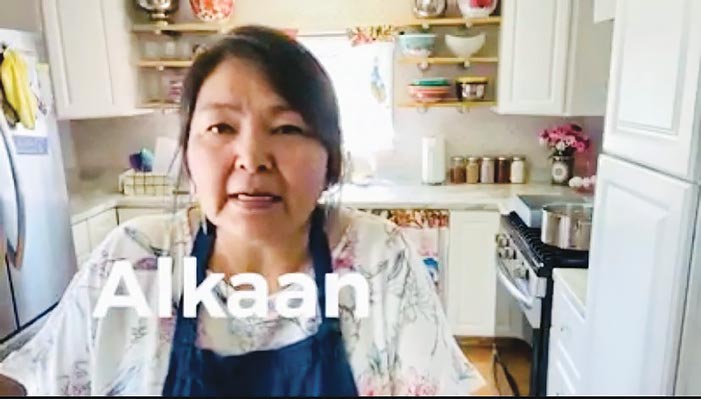
Former Miss Navajo spends curfew making recipe videos

Navajo Times | Arlyssa Becenti In this screen shot, Jennifer Jackson-Wheeler is in her kitchen explaining in Navajo how to make alkaan. Her cooking demo project can be viewed on her Facebook page.
WINDOW ROCK
Dr. Jennifer Jackson-Wheeler is a former Miss Navajo, an associate professor, grandmother and a lover of cooking. She has combined all these attributes into making short cooking videos in Navajo and posting them on Facebook for her one-year-old granddaughter.
“I do what I can with family, sharing knowledge given to me by my mother, Ella Jackson, my aunts, and my late grandmother, but when I became a grandparent recently, it changed me,” said Jackson-Wheeler.
“Our one-year-old nálii, Elizabeth Nihaaníbaa’, influences me even more these days to share our language with our people,” she said. “I am doing this new project for her and for all my grandchildren (sisters’ and brothers’ grandchildren).”
In one video Jackson-Wheeler is in her bright kitchen with her long hair tied back, ready to start making Alkaan, which is made during a Navajo girl’s coming of age ceremony, a kinaalda. But Jackson-Wheeler states that you can make this treat at home any time and enjoy it.
Throughout the video, which she tries to keep 10 to 15 minutes long, she speaks only in Navajo for everything from ingredients to kitchen tools.
There are also captions spelling out kitchen tools she is using in Navajo. This video had 799 shares and over 100 comments from people giving their appreciation for the video and recipe.
“I also try to make and share my recipes based on what Facebook family and friends request,” said Jackson-Wheeler. “I plan to demonstrate both Navajo and non-Navajo foods, such as an apple pie recipe without measuring, which I learned from my aunt who lives in Wichita.”
With the coronavirus on Navajo Nation keeping many people including Jackson-Wheeler, inside, she said she doesn’t go to the grocery store as often. In her cupboard she has the Navajo basics of white corn, blue corn, flour, sumac, ash and cornhusks.
Jackson-Wheeler said Navajo was her first language and it was her grandmother, Elizabeth Wauneka, who encouraged her grandchildren to speak Navajo and to be proud of who they are as Diné.
“She used to remind us to remember our people who suffered during the Long Walk era, and to do whatever we could to honor our ancestors and carry their teachings forward,” said Jackson-Wheeler. She is an associate professor of English at Navajo Technical University and chair of faculty at the university’s Chinle campus.
The coronavirus has impacted the school tremendously, she said, but despite this students, faculty, staff and administrators have demonstrated “resilience and strength” through collaboration and support of each other. “Many (students) lack basic learning tools, such as laptops and Internet, things that many of us take for granted,” said Jackson-Wheeler. “We are still working together to loan laptops to students, many located in remote areas.
As a public service, the Navajo Times is making all coverage of the coronavirus pandemic fully available on its website. Please support the Times by subscribing.
How to protect yourself and others.
Why masks work. Which masks are best.
Resources for coronavirus assistance
“We are trying to provide financial support for students so they can purchase hotspot capabilities through their phone providers,” she said.
Although her videos showcase her pristine Navajo pronunciation, she posts that anyone can learn the recipes by listening and observing. Language revitalization has been a priority to her.
She has even created Navajo language courses in urban areas. Not only that, she has coordinated Indigenous language workshops and training. She has translated hundreds of documents and literature. She has also made many presentations for youth and communities, at times with her mother. She’s also received awards for her language revitalization efforts, helped with translation and adaptation of major movies and volunteered for nonprofit organizations to share the Navajo language.
“The first step of learning any language is listening to the language,” she said. “Hearing the language constantly will enhance the learning. “This is the main reason for my recording these videos all in Navajo,” she said. “I could easily make these videos in English, of course, but my primary focus is to speak Navajo so our non-Navajo speakers can listen.”
After listening the next step is speak Diné Bizaad. Then repeat the language, pronouncing it as best you can, even if you don’t understand it. “Today we have so many resources online — in particular, video,” said Jackson-Wheeler. “Full immersion of the language is ideal, but whatever you can access is a start.”
To watch the videos, visit Jennifer Jackson-Wheeler’s Facebook page. The videos are public.








 Highway 264,
Highway 264, I-40, WB @ Winslow
I-40, WB @ Winslow